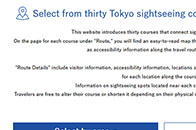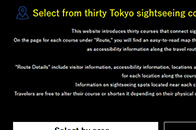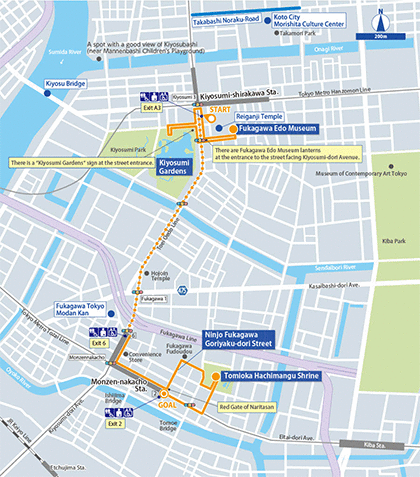Last updated March 31, 2025
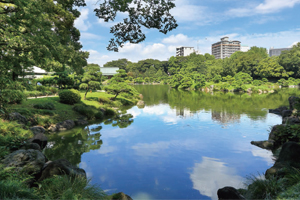
A sophisticated and warm temple town
19. Fukagawa
Enjoy historic temples, shrines, and gardens as well as an old Edo atmosphere while taking in the crisscrossing canals and rivers. This is a course where you can fully enjoy the history and atmosphere of Oedo Fukagawa.
- Joto
- Culture/History
- Downtown
Route
Select a spot to see details such as tourist information and barrier-free information.
- Start Tokyo Metro, Toei SubwayKiyosumi-shirakawa Station [Exit A3]
About 3 minutes on foot
 About 180 meters
About 180 meters - Spot1 Kiyosumi Gardens
About 6 minutes on foot
 About 350 meters
About 350 meters - Spot2 Fukagawa Edo Museum
About 5 minutes on foot
 About 300 meters
About 300 meters - Station Toei SubwayKiyosumi-shirakawa Station [Exit A3]
About 2 minutes by train
 1st stop
1st stop - Station Toei SubwayMonzen-nakacho Station [Exit 6]
About 7 minutes on foot
 About 400 meters
About 400 meters - Spot3 Ninjo Fukagawa Goriyaku-dori Street
About 5 minutes on foot
 About 250 meters
About 250 meters - Spot4 Tomioka Hachimangu Shrine
About 5 minutes on foot
 About 250 meters
About 250 meters - Goal Tokyo MetroMonzen-nakacho Station [Exit 2]
- Information used in the creation of this website was current as of January 2023
- Indicated route travel times are calculated based on a speed of about 60 meters/minute
Route Details
There is also useful information for when you actually visit a spot, such as the time required, details on restrooms, and travel time between spots.
Explanation of PictogramsNote Items are indicated in dark blue if applicable.
-

- Wheelchair-accessible restroom (located within the ticket gates at train and subway stations unless noted otherwise)
-

- Nursing area (with diaper-changing table, unless noted otherwise)
-

- Written communication possible through communication boards or paper
-

- Ostomate-friendly facility
-

- Parking for the impaired
-

- Explanations, etc. available through tactile maps or in Braille

-
Start Tokyo Metro, Toei Subway Kiyosumi-shirakawa Station [Exit A3]
The course starts at Exit A3 of Tokyo Metro, Toei Subway Kiyosumi-shirakawa Station.
For station details, refer to the Tokyo Metro website and the Toei Subway website operated by the Tokyo Metropolitan Government Bureau of Transportation.Toei Subway website operated by the Tokyo Metropolitan Government Bureau of Transportation
-
About 3 minutes on foot
 About 180 meters Travel Tips There is a "Kiyosumi Gardens" sign at the entrance.
About 180 meters Travel Tips There is a "Kiyosumi Gardens" sign at the entrance. -
Spot1 Kiyosumi Gardens About 30 minutes

A captivating strolling garden commissioned by the legendary entrepreneur Yataro Iwasaki. This classic Meiji-era style garden features serene ponds, artificial hills, and dry landscapes. As you stroll around the pond, arranged with exquisite stones, you will experience Japan's timeless beauty reflecting the changing seasons.
Accessibility Information
There is a route available for wheelchair users with little level differences. Rental suspension wheel-type wheelchairs (which cut down on vibration) are available.
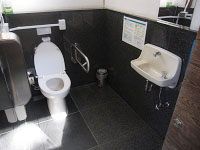
Wheelchair-accessible restroom at the entranceway Restroom Information
There is one wheelchair-accessible restroom available at the entranceway (next to the Taisho Memorial Hall) and another on the grounds. Wheelchair-accessible restrooms (with diaper-changing seats) are located in the gardens.
Facility Information
- Telephone number
- 03-3641-5892 (Tokyo Metropolitan Park Association)
- Address
- 3-3-9, Kiyosumi, Koto-ku
- Fee
- ¥150 (Discounts available for seniors on production of their ID, people with impairments on production of their disability certificate issued in Japan, and caregivers.)
- Hours
- 9:00 - 17:00 (admission until 16:30)
- Closed days
- None
- Official Website
- https://www.tokyo-park.or.jp/park/kiyosumi/index.html
*This information was current as of January 2025. Contact individual facilities to confirm details.
-
About 6 minutes on foot
 About 350 meters Travel Tips There are Fukagawa Edo Museum lanterns at the entrance to the street facing Kiyosumi-dori Avenue.
About 350 meters Travel Tips There are Fukagawa Edo Museum lanterns at the entrance to the street facing Kiyosumi-dori Avenue. -
Spot2 Fukagawa Edo Museum About 1 hour
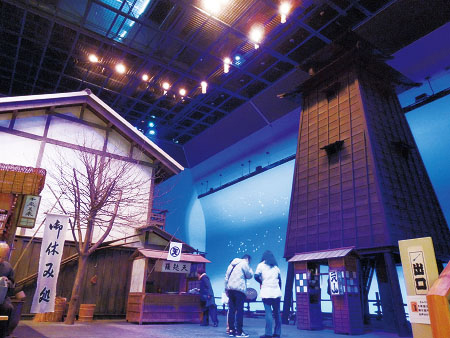
This museum replicates the town of Fukagawa-Sagacho during the late Edo period. A day in the lives of the people of that time is presented with sound effects (vendors selling their goods, "beware of fire" warnings, etc.) and lighting effects.
Accessibility Information
Notify the staff if you wish to use the elevator togo to the exhibit on the basement floor.
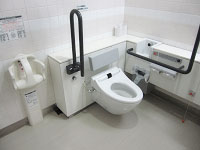
Wheelchair-accessible restroom on 1st basement floor Restroom Information
There are wheelchair-accessible restrooms located on the 1st and B1 floors. A wheelchair-accessible restroom with ostomate facilities is located on the 1st floor. There are also diaper-changing tables in the 1st floor women’s restroom and the B1 wheelchair-accessible restroom.
Facility Information
- Telephone number
- 03-3630-8625
- Address
- 1-3-28, Shirakawa, Koto-ku
- Fee
- ¥400 (Discounts available for people with impairments and caregivers. Inquire for details)
- Hours
- 9:30 - 17:00 (admission until 16:30)
- Closed days
- 2nd and 4th Mondays (open when the Monday is a national holiday)
- Official Website
- https://www.kcf.or.jp/fukagawa/
*This information was current as of January 2025. Contact individual facilities to confirm details.
-
About 5 minutes on foot
 About 300 meters
About 300 meters Toei Subway Kiyosumi-shirakawa Station [Exit A3]
About 2 minutes by train
 1st stop
1st stop Toei Subway Monzen-nakacho Station [Exit 6]
About 7 minutes on foot
 About 400 meters
About 400 meters -
Spot3 Ninjo Fukagawa Goriyaku-dori Street About 20 minutes
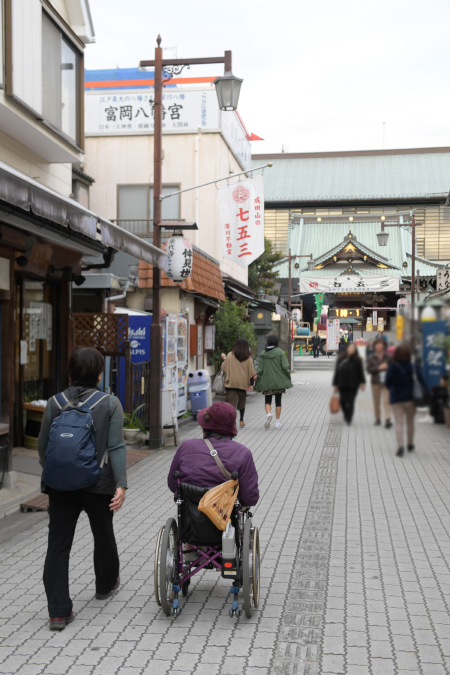
The approach to the Fukagawa Fudo Temple stretches some 150 meters from Eitai-dori. The temple area shopping street is typically lively, with some 40 establishments including restaurants as well as shops offering Japanese sweets and Edo-style accessories.
Accessibility Information
The road leading to the temple has no inclination or steps, making wheelchair use easy. Exercise caution on the 1st, 15th, and 28th of the month (temple fair days), as it tends to be crowded.
Restroom Information
There are no public restrooms on the street.
Facility Information
- Telephone number
- -
- Address
- Koto-ku
- Fee
- -
- Hours
- Varies by shop
- Closed days
- Varies by shop
*This information was current as of January 2025. Contact individual facilities to confirm details.
-
About 5 minutes on foot
 About 250 meters
About 250 meters -
Spot4 Tomioka Hachimangu Shrine About 20 minutes
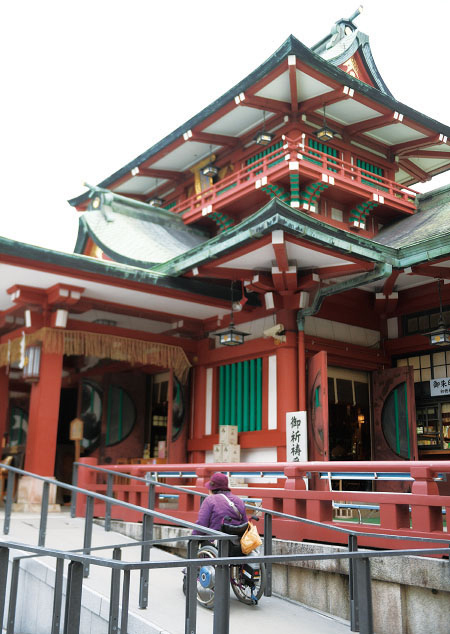
This shrine is well-known for the Fukagawa Hachiman Festival, which is regarded as one of the three great festivals of Edo. As the birthplace of sumo as athletic entertainment, it has a deep connection to the sport, with Yokozuna and Ozeki monuments on the grounds.
Accessibility Information
There are ramps available next to the stairs on the grounds as well as on both sides of the outer shrine (at approximately eight degrees). Be cautious on the path leading to the Yokozuna monument to the side of the outer shrine as it slopes ten degrees. Though there is no dedicated nursing room, you may ask the administrative office for assistance if you require nursing facilities.
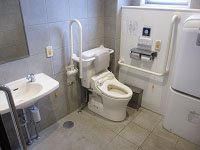
Wheelchair-accessible restroom on the premises (west approach) Restroom Information
Wheelchair-accessible restrooms (with diaper-changing seats) are located in the men's restroom on the premises (west approach).
Facility Information
- Telephone number
- 03-3642-1315
- Address
- 1-20-3, Tomioka, Koto-ku
- Fee
- Free entry to grounds
- Hours
- Free entry to grounds
- Closed days
- Free entry to grounds
- Official Website
- http://www.tomiokahachimangu.or.jp/
*This information was current as of January 2025. Contact individual facilities to confirm details.

There are ramps installed on the grounds and at the front shrine.
-
About 5 minutes on foot
 About 250 meters
About 250 meters
-
Goal Tokyo Metro Monzen-nakacho Station [Exit 2]
The course finishes at Exit 2 of Tokyo Metro Monzen-nakacho Station.
For station details, refer to the Tokyo Metro website.
Sightseeing spots around Fukagawa
-
Spot5 Koto City Morishita Culture Center
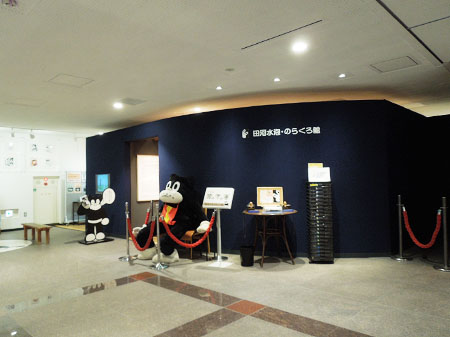
The Tagawa Suiho Norakuro Hall introduces the achievements of manga artist Tagawa Suiho (author of the comic “Norakuro”), who grew up in this area. The Koshokan Hall exhibits crafts created by holders of intangible cultural properties designated by the city.
Accessibility Information
Tactile blocks lead to the 1st floor office window. The facility can be toured by wheelchair users without any problem.
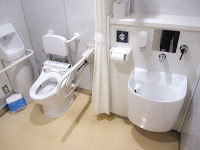
Wheelchair-accessible restroom on 1st floor Restroom Information
There are wheelchair-accessible restrooms on the 1st to 4th floors. The 1st floor restrooms have ostomate facilities.
Facility Information
- Telephone number
- 03-5600-8666
- Address
- 3-12-17, Morishita, Koto-ku
- Fee
- Free admission
- Hours
- 9:00 - 22:00
- Closed days
- 1st and 3rd Mondays (open when the Monday is a national holiday)
- Official Website
- https://www.kcf.or.jp/morishita/
*This information was current as of January 2025. Contact individual facilities to confirm details.
-
Spot6 Takabashi Noraku-Road

This shopping street is known for Norakuro, the comic by manga artist Tagawa Suiho. The street is closed to vehicles on Sundays and holidays.
Accessibility Information
There are tactile blocks near intersections, and level differences have been removed.
Restroom Information
Wheelchair-accessible restrooms (with diaper-changing seats) are located at Takamori Park, which is next to the Koto Morishita Culture Center on the east side.
Facility Information
- Telephone number
- Varies by shop
- Address
- Takabashi, Koto-ku
- Fee
- -
- Hours
- Varies by shop
- Closed days
- Varies by shop
*This information was current as of January 2025. Contact individual facilities to confirm details.
-
Spot7 Kiyosu Bridge
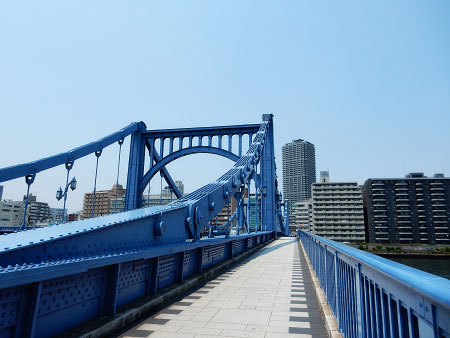
This bridge, which spans the Sumida River, has been designated an Important Cultural Property. It is modeled after a bridge over the Rhine River in Cologne, Germany, which was said to be the most beautiful in the world.
Accessibility Information
There is an observation point from which one can view the Kiyosu Bridge near the confluence of the Sumida and Onagi Rivers.
Restroom Information
There are no public restrooms.
Facility Information
- Telephone number
- -
- Address
- Chuo-ku, Koto-ku
- Fee
- Free
- Hours
- Free
- Closed days
- Free
*This information was current as of January 2025. Contact individual facilities to confirm details.
-
Spot8 Reiganji Temple
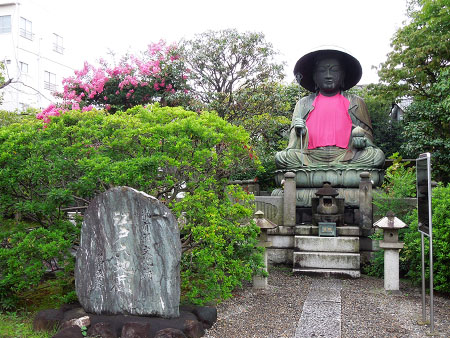
A historic temple with one of the six bronze Jizo statues of Edo and numerous graves of daimyo lords including Matsudaira Sadanobu of the Kansei reforms.
Accessibility Information
An absence of level differences and inclines at the entrance/exit and on the grounds enables smooth wheelchair movement. However, the ground in front of the Jizo statue is covered in gravel.
Restroom Information
There are no wheelchair-accessible restrooms.
Facility Information
- Telephone number
- 03-3641-1523
- Address
- 1-3-32, Shirakawa, Koto-ku
- Fee
- Free entry to grounds
- Hours
- -
- Closed days
- None
*This information was current as of January 2025. Contact individual facilities to confirm details.
-
Spot10 Fukagawa Tokyo Modan Kan
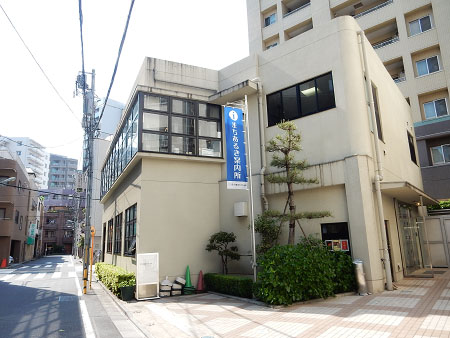
This facility was built as a cafeteria operated by the city of Tokyo in 1932. Serving as a tourism and cultural center, it is used as a base for touring around the Monzen-nakacho area.
Accessibility Information
The front of the building (east entrance) has a ramp, enabling smooth entry by wheelchair users.
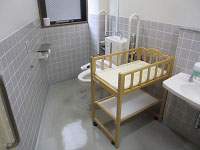
Wheelchair-accessible restroom Restroom Information
The passageway leading to the wheelchair-accessible restroom is slightly narrow (87 centimeters). The restroom has a diaper changing table.
Facility Information
- Telephone number
- 03-5639-1776
- Address
- 1-19-15, Monzennakacho, Koto-ku
- Fee
- Free admission
- Hours
- 10:00 - 18:00 (until 19:00 on Friday and Saturday)
- Closed days
- Mondays (the following day if Monday is a national holiday)
- Official Website
- http://www.fukagawatokyo.com/
*This information was current as of January 2025. Contact individual facilities to confirm details.

